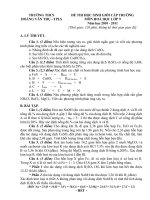trường thcs hoàng xuân hãn
Bạn đang xem bản rút gọn của tài liệu. Xem và tải ngay bản đầy đủ của tài liệu tại đây (104.56 KB, 2 trang )
<span class='text_page_counter'>(1)</span><div class='page_container' data-page=1>
11th Bay Area Mathematical Olympiad
BAMO-12 Exam
February 24, 2009
The time limit for this exam is 4 hours. Your solutions should be clearly written arguments. Merely stating
an answer without any justification will receive little credit. Conversely, a good argument which has a few minor
errors may receive substantial credit.
Please label all pages that you submit for grading with your identification number in the upper-right hand
corner, and the problem number in the upper-left hand corner. Write neatly. If your paper cannot be read, it
cannot be graded! Please write only on one side of each sheet of paper. If your solution to a problem is more than
one page long, please staple the pages together.
The five problems below are arranged in roughly increasing order of difficulty. Few, if any, students will
solve all the problems; indeed, solving one problem completely is a fine achievement. We hope that you enjoy
the experience of thinking deeply about mathematics for a few hours, that you find the exam problems interesting,
and that you continue to think about them after the exam is over. Good luck!
Note that the five problems are numbered 3–7. This is because BAMO-8, the middle-school version, has four
problems, numbered from 1 to 4. The two hardest problems of BAMO-8 are the first two problems of BAMO-12.
So collectively, the problems of the two BAMO exams are numbered 1–7.
Problems
3 There are many sets of two different positive integers aandb, both less than 50, such thata2andb2
end in the same last two digits. For example, 352=1225 and 452=2025 both end in 25. What are all
possible values for the average ofaandb?
For the purposes of this problem, single-digit squares are considered to have a leading zero, so for
example we consider 22to end with the digits 04, not 4.
4 Seven congruent line segments are connected together at their endpoints as shown in the figure below at
the left. By raising pointEthe linkage can be made taller, as shown in the figure below and to the right.
Continuing to raiseEin this manner, it is possible to use the linkage to makeA,C,F, andE collinear,
while simultaneously makingB,G,D, andEcollinear, thereby constructing a new triangleABE.
Prove that a regular polygon with centerEcan be formed from a number of copies of this new triangle
ABE, joined together at pointE, and without overlapping interiors. Also find the number of sides of this
polygon and justify your answer.
A B
C
D
E
F
G
A B
C G
F D
</div>
<span class='text_page_counter'>(2)</span><div class='page_container' data-page=2>
2
5 A setSof positive integers is calledmagicif for any two distinct members ofS,iand j,
i+j
GCD(i,j)
is also a member of S. TheGCD, or greatest common divisor, of two positive integers is the largest
integer that divides evenly into both of them; for example,GCD(36,80) =4.
Find and describe all finite magic sets.
6 At the start of this problem, six frogs are sitting at each of the six vertices of a regular hexagon, one
frog per vertex. Every minute, we choose a frog to jump over another frog using one of the two rules
illustrated below. If a frog at pointF jumps over a frog at pointP, the frog will land at pointF0 such
thatF,P, andF0are collinear and:
• using Rule 1,F0P=2FP.
• using Rule 2,F0P=FP/2.
<i> Rule 1 Rule 2</i>
<i><b>F'</b></i>
<i><b>F'</b></i>
<i><b>F</b></i>
<i><b>P</b></i>
<i><b>P</b></i>
<i><b>F</b></i>
It is up to us to choose which frog to take the leap and which frog to jump over.
(a) If we only use Rule 1, is it possible for some frog to land at the center of the original hexagon after
a finite amount of time?
(b) If both Rule 1 and Rule 2 are allowed (freely choosing which rule to use, which frog to jump, and
which frog it jumps over), is it possible for some frog to land at the center of the original hexagon
after a finite amount of time?
7 Let4ABCbe an acute triangle with anglesα,β, andγ. Prove that
cosα
cos(β−γ)+
cosβ
cos(γ−α)+
cosγ
cos(α−β) ≥
3
2.
You may keep this exam.Please remember your ID number!Our grading records
will use it instead of your name.
You are cordially invited to attend theBAMO 2009 Awards Ceremony, which
will be held at the Mathematical Sciences Research Institute, from 11–2 on Sunday,
March 8. This event will include lunch, a mathematical talk by Francis Su of
Harvey Mudd, and the awarding of dozens of prizes. Solutions to the problems
above will also be available at this event. Please check with your proctor for a
more detailed schedule, plus directions.
</div>
<!--links-->









